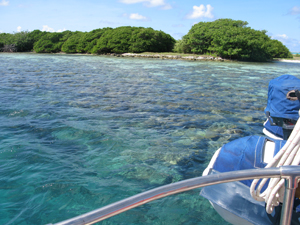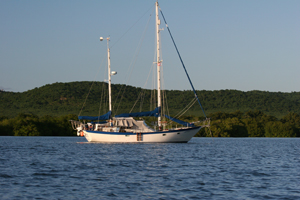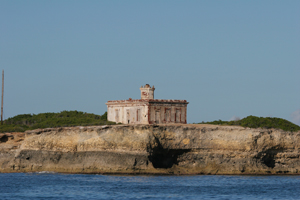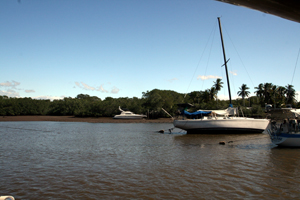A variety of situations with the potential for going aground have arisen during the last 41 years of cruising, 15 of those years full time living aboard our 47-foot ketch Carricklee. Although the experience of going aground can be traumatic, in some cases having serious consequences, most instances of going aground amount to little more than an inconvenience. In either case, though, what we do or don’t do when we touch bottom or go aground determines whether the situation becomes serious or merely a minor inconvenience.
 |
|
When the bottom is this close, at Bonaire in the Caribbean, extra care is required to avoid the scene below.
|
After all these years of voyaging, we think we’ve probably either bounced along the bottom or gone aground in virtually every country we’ve visited. While some of the events leading up to our going aground have resulted from our taking a calculated risk, most were the result of the everyday kinds of decisions cruising sailors make, always alert to the possibility of going aground.
The most recent example of a potential grounding of our boat occurred last spring when we were following the pilot boat through the long channel into the Costa Rica Yacht Club in Puntarenas, Costa Rica. Within 100 yards of the mooring area, we slowed to barely more than idle speed ahead, knowing the water depths around the moorings are at best barely enough for our boat’s six-foot draft. Shortly thereafter, our boat slowed even more, and muddy water boiled up astern in our wake. We were dragging the keel through the soft mud on the bottom of the bay. However, because we’d visited the yacht club two or three times previously and because we knew the tide was on the flood, we were fairly certain we could safely increase the throttle to power the boat the last short distance to the pilot boat awaiting us at a mooring with seven feet of water.
Such a passing threat of grounding is not an uncommon occurrence whenever our cruising destinations are up inside estuaries or rivers. Nevertheless, we recognize the risks in powering through the mud. In this particular circumstance, the greatest risk seemed to be that of hitting a good-sized rock or anchor buried in the mud that could have damaged or grounded the boat.
State of tide
In other circumstances another risk in using this technique can arise if the crew misjudges the state of the tide. In one instance in Richardson Bay, Calif., we were attempting to cross some shallow water to get to the dock of a favorite restaurant in Sausalito. We discovered a high spot in the mud bottom of the bay and attempted to drive the boat through the mud, assuming the incoming tide would soon lift us enough to float the boat. Clearly, we had not paid sufficient attention to the tide tables to know we were coming into this shallow water near low slack and thus should have been going much more slowly. As a result of this inattention to the tide guide, we had an almost two-hour wait for the incoming tide to float the boat above the mud.
Another risk of trying to free a boat aground with the engine is the potential for getting into mud so soft and deep the engine water intake sucks mud, rocks, and other debris into the engine cooling system. We experienced such an outcome when we anchored in Kaunakakai Harbor on the Island of Moloka’i. We had wanted to anchor as far away as we could from the dock where the tugs brought in the large barges throughout the day and night. As we moved away from the dock toward the edge of the dredged bottom, Carricklee stopped abruptly. We couldn’t power forward toward the ever-shallowing water and so could only back up to get into deep water behind us. Doing so in this bay caused enough prop turbulence to pick up debris off the bottom. Mud, sea grass, small rocks and pieces of coral then sucked into the engine intake. Once we had anchored the boat in a suitable part of the bay, we had to remove the seawater strainer and clean out the debris before we could move the boat again.
Hitting the hard stuff
Going aground on a hard bottom is generally more dangerous. In Alaska a few years ago, while we were sailing northward in Frederick Sound, heavy winds and rough seas encouraged us to find immediate shelter for the night. We spotted two large fishing trawlers nearby and followed them into a small bay, unnamed on the chart, which appeared to offer good protection. A number of other fishing boats had ducked into this bay before we arrived, leaving few good anchorage spots. After circling the small bay, we eventually dropped the anchor in 50 feet of water on a somewhat indifferent bottom.
In less than an hour, Carol, who is a light sleeper whom every little change in sound awakens, heard a gentle tapping and scraping beneath our bunk. We were immediately up in the cockpit, and believed we had undoubtedly dragged our anchor over the hard gravelly bottom. As Carol started the diesel and motored ahead at idle, I went to the foredeck to pull in some of the 250 feet of chain I had let out when we had anchored. As we followed the chain toward the anchor, we realized we probably had not dragged at all. Rather, our position had changed because of a wind shift. We had to move the boat quickly nonetheless: the vulnerable rudder was the part of the boat scraping across the rocky bottom. In this case, the only course of action was to hoist and drop anchor in another, more suitable location.
If we had not been aboard, our boat could have sustained some serious damage, even if we had not been pushed up on the shore. As a consequence of these kinds of experiences, we avoid leaving our boat immediately after setting the anchor. Particularly in an anchorage that is unfamiliar or has recognizably unstable holding, we remain aboard for at least an hour to test the security and safety of the anchor set.
 |
|
The Mehaffy’s ketch Carricklee at anchor in the U.S. Virgin Islands. |
In this instance, our decision to escape the heavy winds and seas in the sound by anchoring in this small bay seemed, and still seems, less risky than staying outside. The error was in our misjudging how far the boat could swing on the 250 feet of anchor chain we let out, unaccustomed as we were then to anchoring in 50 feet of water.
Perhaps our most sobering experience of barely escaping going aground on a hard surface came at the end of our passage from one of the Dutch Antilles, Isla Bonaire, to Isla de Aves, the Venezuelan islands due east. When we spotted the Aves rising above the horizon 10 miles away, we considered our options. The first was to spend the night at sea. The second option was to study the guidebook for the Aves and choose an anchorage we might be able to get into safely. Though indeed risky, the latter option, we decided, was worth trying. One anchorage seemed to fit that category, and, even though we have a rule never to enter an anchorage in the tropics when the sun is close to setting, we decided to give it a try.
And indeed we were in the protected water of the Aves as the sun was minutes away from disappearing below the horizon. Using radar, paper charts, electronic charts, and the guidebook, we made our way slowly the last mile to the recommended anchorage area, passing reefs and small islands along the way. As we turned to port to enter the anchoring spot shown on the sketch in the guidebook, the sun dropped beneath the horizon, darkness rapidly approached, and we could no longer see the reefs around us. The depth sounder showed nearly 50 feet of water, so we cautiously moved forward at idle speed. When the depth abruptly went from 50 to 12 feet, Carol quickly shifted into reverse and backed down to stop our forward motion.
Harsh scraping
As our forward motion slowed, the 12-knot wind then on our starboard beam pushed Carricklee toward the reef we’d identified on the electronic chart. Just as the forward motion stopped, we heard the harsh scraping of coral against the port side of the hull. Fortunately, when in reverse our boat backs to starboard, so we continued slowly to back off, steeling ourselves for the worst. The teeth-gritting scrape lasted only a few moments before we were clear of the reef.
We then pointed the bow into the wind and returned to 50-foot depths, where we dropped the anchor and backed down to set it — this latter requiring three attempts before the anchor held on the rocky bottom. When the boat came to rest in a safe 24 feet of water, we busily began checking for water intrusion.
 |
|
A contributing factor to going aground at night can be damaged or missing aids to navigation. |
A short time later, after concluding the hull had sustained no serious damage but still shaking, we sat in the cockpit to study our position and to discuss the incident. We had clearly made two notable mistakes. Despite the miserable sea conditions we were trying to escape, we shouldn’t have broken our rule not to enter an unfamiliar anchorage so close to darkness. Though the winds had reached 18 knots, with, of course the accompanying seas outside the protected water of the anchorage, we would have been safer had we either sailed back and forth in the lee of the island or hove-to.
The second mistake we had made was in accepting the absolute accuracy of the sketch in the cruising guide. As we sat in the cockpit that night and looked at the sketch, we could easily see that the reef with which our hull had tangled was not where it was shown to be. Fortunately, we had been going dead slow when we encountered the uncharted reef and averted more serious damage, even a grounding.
The next morning, after a reasonably good night’s sleep — not entirely confident of the anchor set, we slept in the cockpit — we stepped out on deck to survey our situation more closely. The first objective was to examine our anchor chain and snubber. With the wind still blowing in excess of 12 knots, the anchor chain was fairly taut; in the clear water off the bow, the only reef we saw was 100 feet off the port bow. Astern, however, we found a disturbing surprise: The reef we had scraped up against the evening before was only 15 feet from our rudder. Checking the depth sounder, we ascertained the anchor had probably dragged a few feet during the night. We took in 40 of the 200 feet of anchor chain to pull the boat away from the reef.
The next task was to get into the water to check the hull for damage from the reef encounter the evening before. We had no trouble seeing the point of impact on the port side of the hull a little more than a foot below the waterline. The three scrapes were approximately eight feet long and almost an inch wide at the extreme. Although the gouges exposed the gel coat under the many coats of bottom paint, none appeared to have penetrated into the glass matting of the heavy hull.
A similar reef-threatening experience had occurred a few months earlier when we had been exploring Isla de Tintipán, Colombia. We had decided to move to the interior lagoon on the north side of the island to escape the uncomfortable rolls of the south anchorage. The risky decision in this case was accepting the advice of a Colombiano friend in Cartagena who had years of experience going through the reef at Tintipán. Because we had no chart, our friend could mark to identify the route through the reef fringing the entire island, we could only follow his recommendations, this kind of local knowledge usually quite reliable.
After weighing anchor on the south of Tintipán and proceeding around the east end of the island, we set a course about a mile off the north shore. When the depths dropped to 10 feet, Carol throttled back to idle ahead, and I went out on the bow to spot coral heads and point the way through the coral. All too soon we were in seven feet of water and could not be sure which way to turn to deep water. Thinking I could see a possible route, I called for a turn to starboard. In moments, Carricklee was aground on a coral head. We attempted to back off, but the boat did not budge.
A local assist
As we began readying the anchor to kedge the boat off the coral, we saw a man and boy speeding out from shore in a large launch. The man, a local fisherman, came alongside to explain — in Spanish, of course — that he and his boy watched us picking our way through the shallow water and then abruptly stop. He asked if he could help us get off and lead us the remainder of the way into the lagoon. We readily accepted this kind offer. He carried our anchor out in his launch and then dove into the water to set it in the sand. A few minutes later we had pulled our heavy ketch free and were on our way again, following the fisherman and his son slowly the remainder of the way around the island and through the even more challenging reef to access the inner lagoon, Salsipuedes. We gave the fisherman $10, a bargain for us, but, in exchange, he promised to bring us freshly caught fish the next morning.
Our going aground at Tintipán was no doubt the result of misinterpreting the instructions from our local friend; this misinterpretation probably resulting from a combination of difficulties with language but perhaps even more from our not asking him to draw a rough sketch of the route. Although we generally find local knowledge to be extremely helpful, and in some instances essential, we clearly hadn’t asked enough questions of our friend.
Perhaps we have avoided badly damaging or completely destroying our boat simply through luck. Perhaps, too, we take too many chances as we cruise in out-of-the-way locations for which charts are inaccurate or even unavailable. But we know we would never have visited so many unique sites over the last 41 years of cruising if we had not occasionally made decisions that other boaters might consider too risky, those decisions inevitably resulting in our either going aground or risking going aground.
——————
Carolyn and Bob Mehaffy live aboard their 47-foot ketch Carricklee and have sailed extensively in Caribbean and South American waters.

